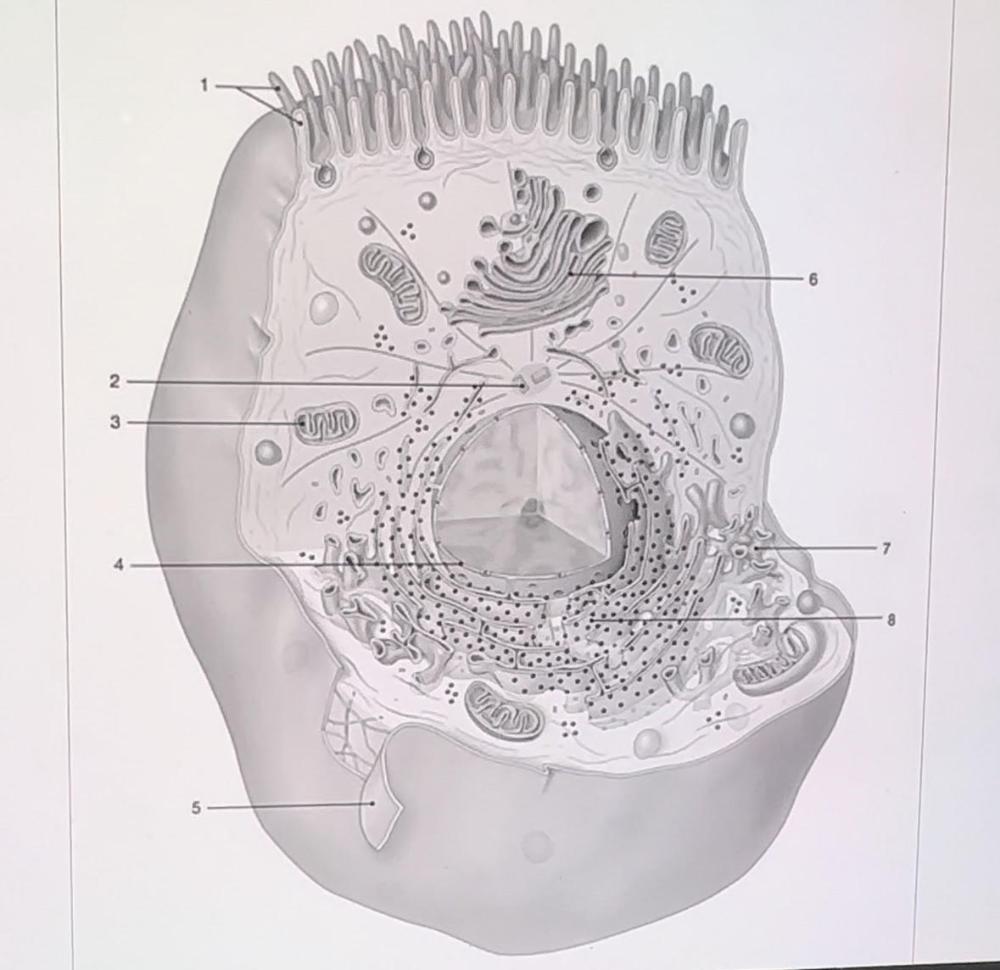The process of forming mRNA is called?
- auscultation
- transcription
- replication
- translation
- ribolation
transcription

What structure organize the mitotic spindle during division?
- 5
- 2
- 3
- 1
- 6
2
Each triplet baes on a gene corresponds to
- one mRNA
- one protein
- one DNA nucleotide
- one amino acid in a protein
- one chromosome
one amino acid in a protein
Microfilament
- are found in the cytoplasm radiating away from the centrosome
- interact with filaments composed of tubulin to produce muscle contractions
- are usually composed of myosin
- anchor the cytoskeleton to integral proteins of the cell membrane
- are hollow, filamentous structures
- anchor the cytoskeleton to integral proteins of the cell membrane
cytology
the structure and function of cells
many protein in the cytosol are ________ that accelerate metabolic reactions
- carbohydrate
- messengers
- ions
- enzymes
- lipids
enzymes
Functions of plasma membrane include all the following except
- separation of cytoplasm from the extracellular fluid
- sensitivity to chemical change in the extracellular fluid
- regulation of exchange of material with the extracellular environment
- structural support
- thermal insulation
thermal insulation
Examination of a sample of glandular cells reveals an extensive network of smooth endoplasmic reticulum. Which of the following is the likeliest product of the cells?
- transport protein
- digestive enzymes
- antibodies
- protein hormones
- steroid hormones
steroid hormones
Which of the following best describes osmosis?
- active transport of water across the cell membrane
- diffusion of water from a greater to lesser water concentration across a selectively permeable membrane
- random movement of water due to kinetic energy
- movement of water into a solute
- diffusion of water from a greater to a lesser water concentration
diffusion of water from a greater to lesser water concentration across a selectively permeable membrane
The functional units of DNA that contain the instructions for making one or more proteins are
- chromosomes
- RNA
- ribosomes
- genes
- condons
genes
All of the following membrane transport mechanisms are passive processes except
- osmosis
- facilitated diffusion
- movement of water
- diffusion
- vesicular transport
vesicular transport
If a cell lacked the enzyme DNA polymerase, it could not
- maintain the integrity of the nuclear envelope
- form a new nuclear membrane during telophase
- form spindle fibers
- link segments of DNA together
- form complementary strands
form complementary strands of DNA during replication
Which of these substances could be driven across a membrane by the resting membrane potential?
- Na+
- CO2
- glucose
- H2O
- O2
Na+
Embryonic stem cells might be used to replace neurons lost in Parkinson's Disease because
- they have not yet differentiated
- they are readily available
- they are taken from the brain of the embryo
- they divide quickly
- they are young and vigorous
they have not yet differentiated
Which of the following descriptors regarding cytoplasm false?
- contains less proteins then extracellular fluid
- syrupy or gel-like consistency
- includes cytoskeleton
- includes cytosol
- the material that fills a cell
contains less proteins then extracellular fluid
The enzyme ______ is required for the synthesis of mRNA
- RNA polymerase
- deoxyribose
- RNA synthetase
- ribose
- phosphatase
RNA polymerase
when telomeres get too short after repeated cell divisions.
- the cell dies
- the chromosomes uncoil
- the cell stops dividing
- the cell divides more frequently
- the cell become cancerous
the cell stops dividing
the endoplasmic reticulum is responsible for all of the following except
- lipid synthesis
- passing molecules to the Golgi apparatus
- drug and toxin neutralization
- modification of new proteins
- housing the chromosomes
housing the chromosomes